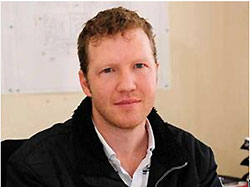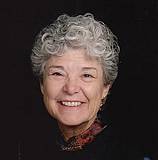Keynote Speakers
Dr Adrian Tiplady

Dr Adrian Tiplady’s “diverse
skills set” have been credited by Professor Justin
Jonas, head scientist of the local Square Kilometre Array
Project (SKA) and Professor of Physics and Electronics at
Rhodes University, as key to South Africa’s bid.
Dr Tiplady prepared the local scientific
proposal - which ran over 27 000 pages - for consideration
by the world’s foremost international experts in the
field, while also having to negotiate with everyone from
farmers to cellular phone executives to help boost South
Africa’s bid.
Fortunately Dr Tiplady has never had
a problem straddling diverse worlds. A gifted saxophonist
and aspiring orchestra conductor, the Durbanite came to
Rhodes University in 1997 to study music. But he also had
an interest in electronics, particularly for “building
stuff”, and astronomy.
He received a Bachelor degree in Physics
and Electronics, Computer Science, Musicology and Compositional
Techniques (with distinction). “I also - sort of illegally
(it wasn’t technically allowed in combination with
his other courses) - majored in the practical performance
side.”
He went on to receive an Honours degree
in Telecommunications and did his PhD in Physics and Electronics,
specialising in Radio Astronomy. His thesis involved the
development of instruments, while he also modelled the precession
of radio pulsars as part of his dissertation.
Dr Tiplady largely credits his own
development in the field to the personal attention he received
at Rhodes, South Africa’s smallest university, where
there is one-on-one teaching, particularly in Physics and
Electronics. “It was a completely different learning
experience than being at one of the large universities,
where you are one of a sea of students, fighting for laboratory
time.”
Still - the music beckoned and during
the completion of his thesis towards the end of 2004, he
was considering moving to Paris to become a jazz musician.
Then he received a call from Prof Jonas, his doctoral supervisor,
asking whether he wanted to get involved in SA’s SKA
bid. He immediately responded to the challenge, initially
taking on the role of developing equipment at the Hartebeesthoek
Radio Astronomy Observatory for the
highly sensitive radio frequency measurements to be conducted
in the Karoo. From here he quickly became involved in compiling
the original submission to host the SKA in 2005, for which
South Africa was shortlisted in 2006.
It was during this time that the local
SKA team decided that in addition to hosting the SKA, South
Africa needed to demonstrate its technical capability. This
led to the establishment of the Karoo Array Telescope (KAT-7),
and Dr Tiplady got increasingly involved, including making
sure that the environment around the SKA bid site, 90 km
outside of Carnarvon in the Northern Cape, is radio quiet.
Radio telescopes are extremely sensitive
instruments - the SKA telescope will be able to pick up
radar fifty light years away. This can be seriously impeded
by cellphone and televisions signals, as well as the electromagnetic
interference generated from electrical devices such as cars.
(The telescope can be affected by a car 11 km away.)
Dr Tiplady is one of the driving forces
in establishing - through the Astronomy Geographic Advantage
Act, declared in 2007 - the protected area commonly known
as the Karoo Radio Astronomy Reserve, which is uniquely
protected from activities detrimental to radio astronomy.
Apart from getting government on board,
Dr Tiplady also had to consult with and educate everyone
from broadcasters and cellphone groups to farmers and representatives
of the local population - some 35 000 people - to limit
the spread of particularly telecommunication signals. “It
was important to get the buy-in from all stakeholders,”
says Dr Tiplady.
Another threat for the SKA bid was
the energy giant Shell’s plans for hydraulic fracturing
(fracking) in the Karoo. This technology extracts natural
gas trapped in the rock several kilometres beneath the earth’s
surface through the injection of water, sand and chemicals
at extremely high pressures. The electromagnetic interference
from the heavy machinery used for the process has the potential
to interfere with the SKA telescopes if not properly coordinated,
explains Dr Tiplady, who now serves on the Working Group
of the South African Inter Ministerial Task Team on Shale
Gas and Hydraulic Fracturing.
Apart from establishing the protected
area around the site, Dr Tiplady’s main responsibility
was putting together the bid documentation. The final proposal
was submitted last year. The document detailed the atmospheric,
geotechnical and meteorological characteristics of the site,
including information about aspects like humidity, wind
and radio frequencies. Specifics about planned and existing
infrastructure, the design of electricity supplies, all
buildings, civil engineering works and data connectivity
plans had to be set out in the document, along with the
total costing.
Since South Africa’s bid also
involves eight other African countries, Dr Tiplady had to
include substantial information about transport costs and
logistics as well as cross border regulations and customs
and excise duties. It has been seven gruelling years, and
at times Dr
Prof Carol Saunders
 Carol
S. Saunders is Professor of Management at the University
of Central Florida. She is a LEO award winner for lifetime
accomplishments to the IS discipline and an Association
of Information Systems Fellow.
Carol
S. Saunders is Professor of Management at the University
of Central Florida. She is a LEO award winner for lifetime
accomplishments to the IS discipline and an Association
of Information Systems Fellow.
She served on a number of editorial boards, including
a three-year term as Editor-in-Chief of MIS Quarterly. She
also served as General Conference Chair of a premier Information
Systems (IS) conference, ICIS. Her outstanding research
status is reflected in over 50 publications in top-ranked
Information Systems, Computer Science, Management and Communications
journals. She held a Distinguished Fulbright Scholar Chair
at the Wirtschaftsuniversität Wien (WU) and further research
chairs in New Zealand, Singapore, and the Netherlands. In
2012, she was guest professor at the Institute of Information
Systems at the FAU Erlangen-Nuremberg.


